Virginia & Truckee Railway
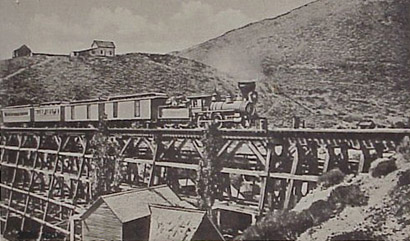 The Virginia & Truckee Railroad Company was incorporated in Nevada in 1868 to provide more efficient and economical transportation between the rich Comstock Lode gold and silver mines of Virginia City and Gold Hill with quartz reduction mills located along the Carson River below Dayton and with lumber yards located near Carson City.
The Virginia & Truckee Railroad Company was incorporated in Nevada in 1868 to provide more efficient and economical transportation between the rich Comstock Lode gold and silver mines of Virginia City and Gold Hill with quartz reduction mills located along the Carson River below Dayton and with lumber yards located near Carson City.
The standard gauge line was completed from Virginia City to Carson City (21 miles) on January 29, 1870. Tracks were extended to interchange with the Central Pacific in Reno (52.2 miles total) on August 24, 1872.
It was incorporated and controlled by the principals of the Union Mill and Mining Company and the Bank of California, Darius Ogden Mills, William C. Ralston and William Sharon. According to rail historian Gilbert Kneiss, the road's owners were sharing a $100,000 monthly profit from the railroad by 1873. As many as 52 trains passed daily over the road.
At Carson City, the railroad built a massive complex of repair shops which serviced the needs of the V & T and numerous mines, mills, railroads, and small concerns throughout the west coast.
In 1880 the owners of the V&T constructed the three foot narrow gauge Carson & Colorado Railroad, connecting with the Virginia & Truckee at Mound House, to serve mining areas to the south extending to Keeler, California. The C&C Business Car No. 10, the Esmeralda, C&C Coach No. 5, and several smaller artifacts are also part Orange Empire Railway Museum's collection.
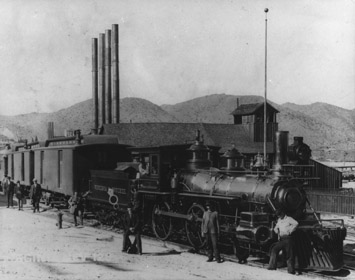 Renowned western engineer John Debo Galloway credited the railroad as "one of the major factors that helped in the revival of mining, the finding of greater ore bodies and the continuous activity of from two to three decades that followed". Noted author Lucius Beebe described the V&T in 1947 as "probably the most publicized of all short line railroads
in the United States ... the glamour girl of all railroads".
Renowned western engineer John Debo Galloway credited the railroad as "one of the major factors that helped in the revival of mining, the finding of greater ore bodies and the continuous activity of from two to three decades that followed". Noted author Lucius Beebe described the V&T in 1947 as "probably the most publicized of all short line railroads
in the United States ... the glamour girl of all railroads".
By the last decade of the nineteenth century the boom days of the Comstock Lode had ended. The C&C's revenue had declined, prompting it's sale to the Southern Pacific in March 1900. Later in the year, however, a boom following the discovery of silver at Tonopah increased revenues of both railroads for the next decade.
The Virginia & Truckee Railway was formed June 24, 1905 to take possession of the Virginia & Truckee Railroad Company and to construct any required extensions.
On August 1, 1906 the V&T opened a new 15.4 mile branch line from Carson City south to Minden to serve the growing agricultural interests of the Carson Valley, this was to be the last track construction on the V&T.
With the increased activity new equipment was added including three new locomotives from Baldwin: No. 25 in 1905, No. 26 in 1907, and No. 27 in 1913. Coach No. 19 was acquired, used, in 1904. A short Express-mail Car No. 20 (later renumbered No. 21) was constructed by the V&T shops in 1906. Combination Car No. 20 was ordered from the Hicks Locomotive and Car Works in 1907.
With the decline in Comstock mining activity and the growing auto and truck competition, the Virginia and Truckee began a gradual decline during the early 1920s. The tracks between Carson and Virginia City were removed late in 1941. Management of the V&T was forced to seriously consider total abandonment of the line in the face of continuing debt. On May 31, 1950, the V&T made its last scheduled run from Minden to Reno.
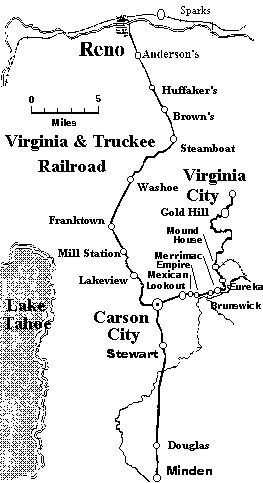 Preservation
Preservation
During the 1930's and 1940's many of the Railway's locomotives and cars were sold to the motion picture studios for use in motion pictures and television shows. A number of these locomotives and cars are now preserved in museums. Three of the Hollywood V&T locomotives, Nos. 18, 22, and 25, and eleven V&T passenger cars have returned from Hollywood to Carson City, Nevada, and are now part of the Nevada State Railroad Museum's collection. Virginia & Truckee locomotives, Nos. 12, 13, and 21 are preserved at California State Railroad Museum in Sacramento, as is Combine No. 16. V&T Locomotive No. 20 is preserved at the Pennsylvania Historical Museum, Strasburg. V&T Combine No. 20 is the last V&T passenger car remaining in southern California. V&T Locomotive No. 11, along with V&T Express No. 1 and Coach No. 19 are at Old Tucson, an Arizona film location.
The Carson City Passenger Depot, Gold Hill Depot and the Virginia City Freight Depot are both preserved at their original locations. Locomotive No. 27 was placed on display in Virginia City, it has subsequently become part of the Nevada State Railroad Museum collection along with several cars that had remained in Nevada.
Virginia City line reconstruction as a Heritage Railroad
Reconstruction of the V&T Railroad as a heritage railroad began in Virginia City in 1974 with the first trains operating in 1977. The line now operates a steam locomotive and several cars on a 2.8 miles long line, which follows the original right of way to the Gold Hill Depot. The popular 35 minute train trip, which features a talk about Virginia City mining history, has become a major tourist attraction for the area.
After years of planning, the Nevada Commission for the Reconstruction of the V&T Railway began reconstruction of the line southward from Gold Hill (connection with the current V&T Railroad) in 2005. The first trains ran over the line in August 2009, 11.1 miles South to the "Eastgate Siding" at Mound House. An 1.1 mile extension into Santiago Canyon above the Carson River, to the "Eureka Siding" was completed in December 2009. Extension of the line along the original right of way through the scenic Carson River Canyon to Carson City is currently seeking additional funding.
Combination Car No. 20 exhibited at Orange Empire Railway Museum
On July 20, 1907, Henry M. Yerington, Vice President and General Manager of the V&T, wrote to the Hicks Locomotive and Car Works requesting additional information on their "Standard 60 foot Combination Car" no. 101 described in their circular C393. Hicks responded with the information and a price quotation of $6,000. On August 5, Yerington again wrote Hicks for additional information, stating that the car might suit the V&T needs but questioning $6,000 as "a pretty stiff figure" based on what the V&T had previously paid for passenger cars.
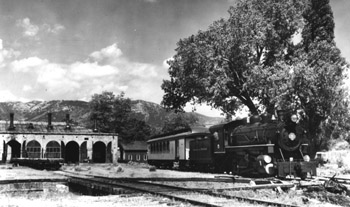 Yerington also wrote to Barney & Smith, Fitz-Hugh Luther Company, and Zelnicker Supply Company requesting quotes on new and used cars, but on August 26, 1907 ordered the Combine from Hicks at a cost of $5,900 f.o.b. Chicago. As the car was going to be used in mixed train service, Yerington requested that the sills be increased in thickness and extra strong platform undersills be added, with Georgia or Oregon pine preferred. Tower couplers were specified. The color was to be yellow. He
wrote that the V&T desired a "high grade car" in every respect, stating "travel is very heavy and a good
coach is sure to attract notice from the numerous railway visitor".
Yerington also wrote to Barney & Smith, Fitz-Hugh Luther Company, and Zelnicker Supply Company requesting quotes on new and used cars, but on August 26, 1907 ordered the Combine from Hicks at a cost of $5,900 f.o.b. Chicago. As the car was going to be used in mixed train service, Yerington requested that the sills be increased in thickness and extra strong platform undersills be added, with Georgia or Oregon pine preferred. Tower couplers were specified. The color was to be yellow. He
wrote that the V&T desired a "high grade car" in every respect, stating "travel is very heavy and a good
coach is sure to attract notice from the numerous railway visitor".
While Yerrington's letter did not specify the trim color to be used, preliminary archeology above both end doors has revealed a dark brown color trim, letterboard color is not known.
On September 10, Yerington forwarded the color scheme for the body, platform, trucks and letterboard; "the latter to bear legend VIRGINIA & TRUCKEE, in gold leaf lettering, and the car to be numbered 20."
Yerington arranged for the construction of the car to be inspected by the American Bureau of Inspection & Tests. On October 9 he was advised that Hicks had completed framing of the floor system, or deck, and expected the car to be ready for painting within three weeks.
In order to save the cost of a messenger on board the car during transit from Chicago to Reno, Yerington requested from the C&NW, UP, and SP that the new Combine be added to the end of their passenger trains. The UP and SP were obliging, but the C&NW was not. After several letters and finally a threat by Yerington to no longer do business with the C&NW, the railroad agreed to place the new car in its fast freight train.
The 60 foot long, 67,000 pound combine left the Hicks plant in Chicago Heights on December 2, 1907, arriving on the V&T December 18. Shipping costs were $350, bringing the total cost for the combine to $6,250.
The local newspapers made note of the combine's first revenue trip on January 18, 1908 praising the fine quality of the car. After it's first run on the V&T, the Territorial Enterprise described the car as "the finest local coach ever shipped to the west". The Nevada State Journal described Combine No. 20 as "one of the best local combination coaches" ever used in the state, "resembling a Pullman built for private use, with its broad windows and gold leaf lettering". Subsequently the Carson News added the car "has all the very latest improvements."
As delivered the combine consisted of three compartments: a baggage section, a smoking compartment seating 16 passengers, and a coach section seating 32 passengers. A swinging door separated the smoking compartment from the coach section. There were two rest rooms, the one for ladies including a wash stand. High back, red upholstered seats were installed in the coach section, and black leather seats were installed in the smoker section. The combine was equipped with two Spear No. 16-D coal car stoves and five pairs of ornate coal oil ceiling lamps.
Combine No. 20 was used only for special occasions until December 30, 1910, when it was put into commission on the local winter train. The V&T was operating two passenger trains between Virginia City and Reno, an express which made the trip in 2 hours, 45 minutes; and a local, a mixed train, which left Virginia City at 7:45 a.m. and arrived in Reno at 11:40 a.m. The local returned, departing Reno at 1:30 p.m. and arriving at Virginia City at 6:30 p.m.
From 1911 through the early 1920's Combine No. 20, occasionally referred to as Caboose No. 20, continued to be used on the local winter trains, replaced during the summer months by either Combine No. 15 or No. 16. Each summer Combine No. 20 was sent to the shops for normal repairs, washing or painting. The only major change recorded during this period was the replacement of the composition roof with a tin one in 1914.
While many of the V&T passenger cars received electric lights in 1917, Combine No. 20 did not, presumably because the car was still being used in mixed train service. Electric lights were installed by 1938, although the actual year is not currently known.
The combine's only known accident occurred in the Winter of 1923 during a severe snow storm. Two local trains had been combined, and headed south with a snow plow on the front. At a deep snow drift the door on a boxcar was torn off, striking cars to the rear of the train. Frank E. Murphy, Vice President and General Manager, wrote that only one window was broken on Combine No. 20, however "all the windows were shattered" on Combine No. 16 which was at the end of the train.
V&T shop records indicate that in 1923 over 500 hours of labor was spent on repairing the Combine No. 20, but the reports do not indicate what work was performed. The combine again returned to the shops in the Fall of 1927, apparently only for minor maintenance and repairs.
In 1924 the railroad experienced its first year without a profit. In June of that year straight passenger train service between Reno and Virginia City was discontinued, replaced by mixed freight and passenger train service. Mixed train service between Carson City and Reno and Carson City and Minden continued daily except Sunday, with railcars being operated on all lines during the quieter times of the day. Regular train service from Carson City to Virginia City was discontinued in 1938.
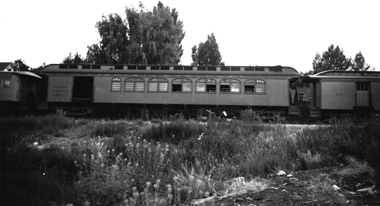 In September 1937, Combine No. 20 again returned to the shops. The baggage
section was enlarged by removing half of the smoking compartment partition,
the men's room, and the smoking compartment seats. This change expanded
the baggage area from 15 feet to 31 feet, allowing the V&T to use
the car for express, baggage and passenger service, and eliminating the
need for a separate express car. Wood slats were placed over the windows
in the former smoking compartment area. Lettering, "RAILWAY EXPRESS
AGENCY" was added to the sides of the car. The change reduced the
passenger capacity to 32. The pieces which were removed were stored in
the Carson City engine house.
In September 1937, Combine No. 20 again returned to the shops. The baggage
section was enlarged by removing half of the smoking compartment partition,
the men's room, and the smoking compartment seats. This change expanded
the baggage area from 15 feet to 31 feet, allowing the V&T to use
the car for express, baggage and passenger service, and eliminating the
need for a separate express car. Wood slats were placed over the windows
in the former smoking compartment area. Lettering, "RAILWAY EXPRESS
AGENCY" was added to the sides of the car. The change reduced the
passenger capacity to 32. The pieces which were removed were stored in
the Carson City engine house.
During the late 1930's the combine was used in regular service along with Mail and Baggage No. 13. In December 1941 Mail, Express and Baggage (Second) No. 21, was placed in service, having been acquired used from the Nevada Northern Railway to replace Mail and Baggage No. 13. Combine No. 20 was also used for several railroad fan excursions.
Combine No. 20 was one of several passenger cars repainted and refurbished
in 1945. On February 2, 1947 Combine No. 20, along with several other
pieces of V&T equipment, took part in an historical film for the Southern
Pacific. The combine's last revenue run on the V&T was in the Reno
Lion's Club Special between Reno and Minden on August 2, 1947.
The Virginia & Truckee had attracted the interest of the Hollywood
motion picture studios. Since 1937 the V&T, which needed money, had
supplied Paramount with two locomotives and ten passenger cars, Twentieth
Century-Fox with a passenger car, and RKO with a locomotive. Metro-Goldwyn-Mayer
(Loew's Inc.) had purchased 1872 built V&T Locomotive No. 11, the
Reno, in 1945.
Desiring 'old-time' passenger cars of their own, MGM again contacted the V&T, purchasing Combine No. 20 along with Coaches No. 8 and No. 19 for $6,000. On August 26, 1947, forty years after the date Combine No. 20 was ordered, the three cars left the V&T for Hollywood to start a new career on the silver screen.
Combine No. 20 is the last V&T passenger car remaining in southern California. V&T Locomotive No. 11, along with V&T Express No. 1 and Coach No. 19 are at Old Tucson, an Arizona film location. The other three Hollywood V&T locomotives, Nos. 18, 22, and 25, and eleven V&T passenger cars have returned from Hollywood to Carson City, Nevada, and are now part of the Nevada State Railroad Museum's collection.
For additional reading:
- Beebe, Lucius and Charles Clegg. Virginia & Truckee:
A Story of Virginia City and Comstock Times. Carson City, Nevada: Nevada State Railroad Museum,
1991.
- Wurm, Ted. Rebirth
of the Virginia & Truckee R.R.: Amazing Revival of a Steam Railroad. Ross, California: May-Murdock
Publications, 1992.
- Wurm, Ted and Harre Demoro. The Silver Short Line: A History of the Virginia & Truckee Railroad. Glendale, California: Trans-Anglo Books, 1983.
Sharing A Heritage Railroad History Train Technology Railroad Operation Railroad Time Museums & Heritage Railroads Railroads Today
Entire website copyright 2002-2013, DigitalNetExpress.com, Burbank, California. |
